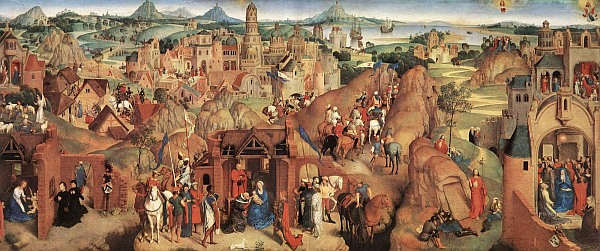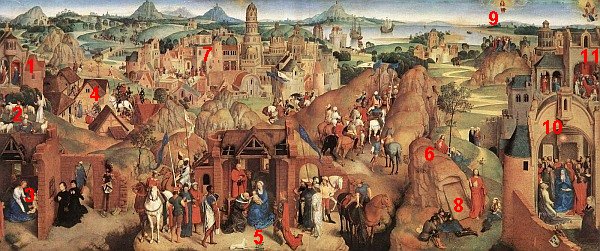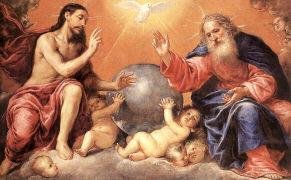|
Unlike pagan religions which see time as an endless cycle, Christians see time as being linear; it has a beginning and will have an end. Within Christianity's linear, "big picture" sense of time, though, the passing of hours is experienced as cycles of meditations on holy things. Think of a spiral -- of a circle of time moving ever forward toward His Coming -- and you will have a sense of "Catholic time."
The Catholic year (the "liturgical year") is made special by cycles of celebrations commemorating the lives of Jesus and His mother, the angels, and the legion of Saints who modelled lives of sanctity. Below are 25 Feasts and times, in chronological order, that demonstrate how the liturgical year is a reliving of the life of Christ:
| Advent |
He is coming |
| Nativity |
He comes |
| Circumcision |
He follows Old Testament Law |
| Epiphany |
He reveals Himself as God |
| Holy Family |
He grows up in a human family |
| Candlemas |
Simeon's prophecy |
| Septuagesima |
We are in exile without Christ |
| Ash Wednesday |
Without Christ, we are dust |
| Lent |
Christ is in the Desert |
| Passion Sunday |
Jews make plans to kill Jesus |
| 7 Sorrows |
Mary's suffers at what is to come |
| Palm Sunday |
He triumphantly enters Jerusalem |
| Spy Wednesday |
Jesus is betrayed by Judas |
| Maundy Thursday |
He offers the first Holy Mass |
| Good Friday |
He is put to death and fulfills Old Testament Law |
| Holy Saturday |
He is in the tomb |
| Easter |
He is risen |
| Ascension |
He ascends into Heaven |
| Pentecost |
He sends the Holy Ghost |
| Trinity Sunday |
The Most Holy Trinity has been fully revealed |
| Assumption |
Mary is assumed into Heaven & crowned Queen |
| Christ the King |
We recognize Christ's Kingship now and forever |
| All Saints |
We will triumph as have our heroic Saints |
| All Souls |
We pray for those who are awaiting their triumph |
Last Sunday in
Time after Pentecost |
Apocalypse. He will come to judge the world. |
Every single year, aware Catholics "re-live" the Gospel, from Christ's Incarnation and Birth to His Ascension and Heavenly reign. In Spring He enters the world by coming to rest in Mary's immaculate womb; nine months later, in Winter, He is born, circumcized, and given a Name. He is raised in the Holy Family, and meets His cousin, John. He goes into the Desert and we go with Him during our Lenten Season. Then follow His Passion and Agony, which are soon vanquished by His Resurrection, His Ascension, and the Pentecost. Now He reigns -- and forever, and we await His Second Coming as we prepare to celebrate again His First Coming. Then the cycle begins again, like a wheel that's been spinning for two millennia. The Catholic who is aware of this wheel is necessarily aware of Christ; the Catholic who also celebrates the Feasts well and practices the traditions of the Church lives intimately with Him.
All of the Church's Feasts1 fall into one of the 2 main "liturgical cycles" made of 7 "liturgical seasons." Each of the Seasons has an associated mood, its own "feeling in the air," its own scents and ornaments. There is even for each Season an associated color which will be reflected in the priests' vestments and liturgical art, church decoration, and so on (though on certain Holy Days within a particular season, that Day's color will take precedence over the season's color). There is a definite rhythm to Catholic life, a rhythm expressed well in this poem by Robert Herrick (1591-1674): Ceremonies for Candlemas Eve
Down with the rosemary and bays,
Down with the misletoe;
Instead of holly, now up-raise
The greener box (for show).
The holly hitherto did sway;
Let box now domineer
Until the dancing Easter day,
Or Easter's eve appear.
Then youthful box which now hath grace
Your houses to renew;
Grown old, surrender must his place
Unto the crisped yew.
When yew is out, then birch comes in,
And many flowers beside;
Both of a fresh and fragrant kin
To honour Whitsuntide.
Green rushes, then, and sweetest bents,
With cooler oaken boughs,
Come in for comely ornaments
To re-adorn the house.
Thus times do shift; each thing his turn does hold;
New things succeed, as former things grow old.
Here's an overview of the two liturgical cycles and their seven seasons -- those times that "do shift".
| Cycle 1: The Christmas Cycle |
|
|
| Season 1: Advent |
| The word "Advent" comes from the Latin "advenire" which means "arrival" and refers to our awaiting the arrival of the commemoration of Christ's birth, and His Second Coming. This somber, penitential season of expectation lasts from the first Sunday of Advent ("Advent Sunday") to 24 December (22 - 28 calendar days). Its color is violet. |
| Season 2: Christmastide |
| As it's the celebration of Christ's Incarnation, the mood of Christmastide is of humble, grateful, joyous celebratration. This season lasts from Vespers of 24 December to 13 January (the Octave of the Epiphany) inclusive (19 calendar days in terms of liturgical calculations). The Feast of Christmas itself lasts 12 days ("The Twelve Days of Christmas"), but the spiritual focus of Christmas doesn't end truly until Candlemas on 2 February. Its color is white or gold. |
| Season 3: Time After Epiphany |
| This season, which continues the Christmas focus on and the Divine Childhood and segues into focusing on Jesus' public ministry, lasts from 14 January to the vigil of Septuagesima Sunday (the ninth Sunday before Easter, which is the same as 3 Sundays before Ash Wednesday) inclusive (4 - 38 calendar days). Its color is green. |
|
| Cycle 2: The Easter Cycle |
|
|
| Season 4: Septuagesima |
| This Season, whose name name means "Seventy" and which recalls the Babylonian Exile, lasts from Septuagesima Sunday to Shrove Tuesday (the day before Ash Wednesday) inclusive (16 calendar days). Its color is violet. |
| Season 5: Lent (Quadragesima) |
This season, also called "Quadraegesima," meaning "Forty," is a somber, penitential Season that recalls Christ's 40 days in the desert, prefigured by the Israelites' wandering in the desert for 40 years.
"Passiontide" is the last two weeks of Lent, from Passion Sunday (the 5th Sunday of Lent) to the day before Palm Sunday. The second week of Passiontide is called "Holy Week." The last three days of Holy Week -- i.e., Maundy Thursday, Good Friday, and Holy Saturday -- are called the Sacred Triduum.
Lent lasts 40 days (but temporally includes six Sundays which aren't counted as "Lent" because Sundays are always about the Resurrection and are joyous), from Ash Wednesday to the Saturday before Easter, with the last three days -- the Sacred Triduum -- being treated separately liturgically speaking (46 calendar days). Its color is violet. |
| Season 6: Paschaltide (Eastertide) |
| The joyous, victorious Easter season lasts from the Easter Vigil to the day before Trinity Sunday (56 calendar days, not counting Easter Vigil). Its color is white or gold. |
|
|
|
| Season 7: Time After Pentecost |
| This Season's focus is the Holy Spirit in the Millennium, the Church Age that we now live in, and Christ's Reign as King of Kings -- the time between the Age of the Apostles and the Age to Come. This season lasts from Trinity Sunday to the day before Advent Sunday (per the calendar, its length varies). Its color is green. |
|
"Overlaid" on this grid of Seasons are two sets of dates: the Proper of Saints (also called the "Sanctoral cycle") and the Proper of Seasons (also called the "Temporal cycle"). The Proper of Saints are Feast Days which are not movable, that is, they fall on the same date each year. The Proper of Seasons are those Sundays and other Feasts of the year, whose dates of celebration depend on the dates of Easter Sunday and Advent Sunday and are, therefore, movable (they change each year).
In other words, to imagine the liturgical year:
- Imagine a regular, standard, everyday calendar
- Mentally overlay on that the Proper of the Saints, filling in each day of the regular calendar with the names of the Feasts for each day, the dates of which don't change -- e.g., January 21 will always be the Feast of St. Agnes, February 3 will always be the Feast of St. Blaise, etc.
- Then determine the dates of the Proper of Seasons and overlay that on top of the Proper of Saints.
To determine the dates of the Proper of Seasons:
- Mark the Season of Easter:
First, we determine the date of Easter, which will be the first Sunday after the first full moon on or after March 21 (even if the full moon on or after March 21 falls on a Sunday, go to the Sunday after). The Vigil of this Feast marks the beginning of Eastertide. - Mark the Season of Time after Pentecost:
Counting Easter as "one," count 9 Sundays forward from Easter and mark that Sunday as the beginning of Time After Pentecost. A Sunday of this Season is referred to as "(First, Second, Third, etc). Sunday after Pentecost." - Mark the Season of Septuagesima:
Counting Easter as "one," count 10 Sundays back from Easter and mark that day as the beginning of Septuagesima. The three Sundays of this Season are referred to, respectively, as Septuagesima Sunday, Sexagesima Sunday, and Quinquagesima Sunday. - Mark the Season of Lent:
Counting Septuagesima Sunday as "one," count 3 Sundays forward from Septuagesima Sunday, then go to the following Wednesday and mark that Wednesday as "Ash Wednesday," the beginning of Lent. A Sunday in this Season is referred to as "(First, Second, Third, etc). Sunday of Lent." - Mark the Season of Advent:
Then, starting with the date of Christmas (always December 25), we count back 4 Sundays to mark Advent Sunday (if Christmas is a Sunday, don't count it; count back 4 entire Sundays so that there are 4 Sundays in Advent). Another way to do this is to simply mark the Sunday closest to St. Andrew's Day (30 November). This date marks the beginning of Advent. A Sunday in this Season is referred to as "(First, Second, Third, etc.) Sunday of Advent." - Mark the Season of Christmas:
Mark the Vigil of December 25 as the beginning of Christmastide - Mark the Season of Time after Epiphany:
Mark January 14 as the beginning of Time After Epiphany. A Sunday of this Season is referred to as "(Second, Third, etc.) Sunday after Epiphany." Note, the first Sunday of this Season is the "Second Sunday after Epiphany," the "after Epiphany" referring to the Feast of the Epiphany, not to the Season.
Then refer to the Temporal Cycle page to fill in any movable Feasts whose dates depend on the date of Easter or Advent Sunday as determined above. The only things left to do are:
- to mark the "Octaves":
Octaves are 8-day periods of observance, beginning with the Feast day itself. Not all Feasts have "Octaves"; only the most important ones do. So, starting with the Feast Day itself, counting it as "one," mark 8 days of the following Feasts as "Octaves": Christmas, Easter, and Pentecost. Then mark the octave before Christmas Eve as "The Golden Nights." - to mark Ember Days and Rogation Days:
- the Wednesday, Friday, and Saturday after the Third Sunday of Advent (Gaudete Sunday) are the days of Advent Embertide
- the Wednesday, Friday, and Saturday after the First Sunday of Lent are known as Lenten Embertide
- the Wednesday, Friday, and Saturday after Pentecost Sunday make up Whit Embertide
- the Wednesday, Friday, and Saturday after the Feast of the Exaltation of the Holy Cross (14 September). Note that these Ember Days must come a full week after the Holy Cross Day.
- Mark the Major Rogation on April 25, and the Minor Rogation on the three days -- Monday, Tuesday, and Wednesday -- before Ascension Thursday
- to mark your cathedral's patronal Feast:
Mark the Feast of the patron Saint of your diocese's cathedral (e.g., if your cathedral is named "SS. Peter and Paul Cathedral," the priests of your diocese will celebrate 29 June, the Feast of SS. Peter and Paul, as a first class Feast)
Now, each of the Sundays of a Season has its own "Propers" -- prayers that are specific to that day in the liturgy (the Divine Office and the Mass). Each of the Feasts in the Proper of Saints will also have its own Propers. So, because the Feasts in the Proper of Saints and the Proper of the Seasons can sometime overlap with two Feasts falling on the same day, all Feasts are ranked according to their importance. The higher ranking Feast will be the one celebrated.
Feasts fall into one of a few categories, in descending order of precedence 2:
- 1st Class
- 2nd Class
- 3rd Class
- Commemoration
When two Feasts of the same rank fall on the same day, they are ranked further by whether they relate to (in descending order of preference):
- Our Lord
- Our Lady
- the Holy Angels
- St. John the Baptist, St. Joseph, St. Peter, St. Paul, the other Apostles
- Martyrs
- Other Saints
If a day is neither a Sunday nor commemorative of any other Feast, it is called a "feria" (the word means "free day").
Holy Days of Obligation
In addition to each Sunday, there are a handful of other Holy Days of Obligation on which we must attend Mass. These Holy Days differ from country to country:
|
United States |
Canada |
England & Wales |
|
Circumcision
Ascension
Assumption
All Saints
Imm. Conception
Christmas |
Circumcision
Epiphany
Ascension
All Saints
Imm. Conception
Christmas |
Circumcision
Epiphany
Ascension
Corpus Christi
SS Peter & Paul
Assumption
All Saints
Christmas |
|
Ireland |
Scotland |
Australia & New Zealand |
|
Circumcision
Epiphany
St. Patrick
Ascension
Corpus Christi
SS Peter & Paul
Assumption
All Saints
Imm. Conception
Christmas |
Circumcision
Epiphany
St. Joseph
Ascension
Corpus Christi
SS Peter & Paul
Assumption
All Saints
Imm. Conception
Christmas |
Circumcision
Ascension
Assumption
All Saints
Christmas |
Other days a family might want to mark on their home calendars are:
- the family's "Name Days"
- the First Friday and First Saturday of each month for devotions to the Sacred Heart and to the Immaculate Heart respectively
- the anniversaries of loved ones' deaths so we remember to have Masses said for them, and light candles, fast, and pray for them
The liturgical year is less confusing than it seems at first, but to follow along, you can do what most Catholics do and just pay attention to your parish bulletins and/or get a Catholic calendar each year. Angelus Press sells a beautiful traditional calendar; their phone number is 1-800-966-7337 (link will open in a new browser window).
For customs and traditions related to the liturgical year, see this page.
Footnotes:
1 In the Novus Ordo:
- the Seasons of Time After Epiphany and Septuagesima have been replaced by "Ordinary Time";
- The Season of Time After Pentecost is referred to also as "Ordinary Time";
- the Feast of the Circumcision is referred to as "Mary, Mother of God";
- Ascension Thursday is celebrated on "Ascension Sunday" (the 7th Sunday of Easter) in some provinces;
- the Feast of Christ the King is not celebrated on the last Sunday of October but on the last Sunday in Pentecost, disrupting the relationship between Christ's Kingship and the Triumph of the Saints celebrated on November 1 (All Saints Day), and leading to the idea that Christ doesn't need to be recognized as King now, on earth, by all nations -- but only after the Last Judgment will His Kingship matter;
- some Saints' Days have been removed from the Calendar (e.g., St. Christopher). Please know that this removal from the liturgical calendar doesn't mean that the Saint in question has been "uncanonized," "de-sainted," or "demoted" as is commonly and frustratingly believed;
- some Feasts have been added;
- Ember Days have been done away with in most places;
- Holy Days of Obligation in the United States are not celebrated if they fall on a Saturday or a Monday;
- the cycle of readings are not based on a yearly cycle but a three-year cycle Results: the entire rhythm of the liturgical year as it's been known for millennia is disrupted; though a greater quantity of Scripture is covered, it is a lower quality of Scripture in that the new readings tend to omit mention of miracles, demons, Hell, evil, the sin of divorce, anything that offends Jews, etc.

2 In older Missals, the Feasts are ranked thus:
| Before mid-1950s |
1962 Equivalent |
| Double of the First Class |
First Class |
| Double of the 2nd Class |
Second Class |
| Greater Double |
Second or Third Class |
| Lesser Double |
Third Class |
| Semi-Double |
Third Class |
| Simple |
Commemoration  |
|
|



